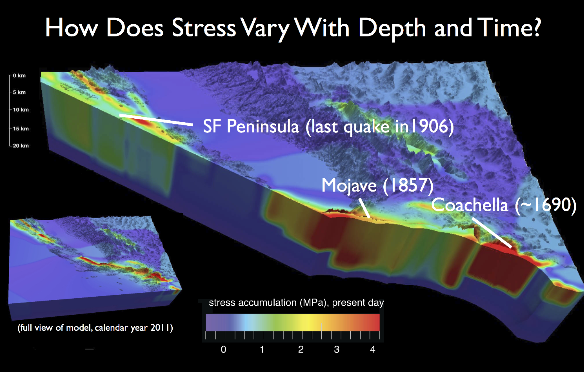Science Nugget - By Bridget Smith-Konter (University of Hawaii at Manoa), David Sandwell (Scripps Institution of Oceanography), and Xiaopeng Tong (University of Washington) - NSF # EAR 0847499/1439697 | 2009-2015
The absence of a major earthquake over the past three centuries along the southern San Andreas fault, a region home to over 10 million people, provides ample motivation for studying the tectonic stress loading conditions of an active plate boundary. GPS data from NSF’s EarthScope Plate Boundary Observatory (PBO) are uniquely positioned to provide a large-scale perspective of plate boundary crustal motions, however techniques for evaluating stress accumulation rates from crustal motion models can vary significantly. One of the fundamental issues is a lack of knowledge of the variable depths to which the San Andreas fault is locked and accumulating tectonic stress. For example, the “locking” depth of the Mojave fault segment near Los Angeles is fairly deep (~17 km), while the depth of Imperial fault segment near the US-Mexico border is much shallower (~6 km). The basic premise is that the more shallowly a fault is locked, the faster it accumulates tectonic stress. In context of seismic hazard models, the likelihood of a major earthquake depends on the amount of accumulated stress and the time since the last major rupture. Therefore, stress rate estimates are only one component of a system-level earthquake hazard model; paleoseismic estimates of the timing and slip of recent (~2000 years) major ruptures are equally important. These data, combined with stress evolution models, can provide critical information about the repeatability of stress patterns for historical earthquakes of the San Andreas fault. This study continues work in this area, exploring one thousand-year earthquake stress evolution models to probe the depths, stress accumulation rates, and stress relationships of the past for seismically active faults in California.
Top figure: Sliced view of present-day (calendar year 2011) Coulomb stress accumulation model of the San Andreas Fault System based on interseismic stress accumulation rate model (Slide 1) and stress changes from 100+ historical and prehistorical earthquake ruptures. Color scale is saturated at 4 MPa to emphasize significant regions of accumulated stress. Labels reading “SF Peninsula (1906)”, b“Mojave (1857)”, and “Coachella (~1690)” refer to segment location and last known significant rupture (calendar year). Stress accumulation is typically lower in regions with a historically recent earthquake (for example, 1906 San Francisco) and higher in regionsvwhere the most recent earthquake dates back a few hundred years (for example, ~1690 event along the Coachella segment). Stress variations with depth are due to transitions in along-strike locking depth. Outset: Full view of 3-Dmodel before vertical slice.
References
Smith-Konter, B. and D.T. Sandwell (2009), Stress evolution of the San Andreas FaultSystem: Recurrence interval versus locking depth, Geophysical Research Letters, 36,doi:10.1029/2009GL037235.
Wei, M., D.T. Sandwell, and B. Smith-Konter (2010), Optimal combination of InSAR and GPS for measuring interseismic crustal deformation, Journal of Advances in Space Research, doi: 10.1016/j.asr.2010.03.013.
Smith-Konter, B., D.T. Sandwell, and M. Wei (2010), Integrating GPS and InSAR to resolve stressing rates of the SAF System, EarthScope inSights, Summer 2010.
Smith-Konter, B., D.T. Sandwell, and P. Shearer (2011), Locking depths estimated from geodesy and seismology along the San Andreas Fault System: Implications for seismic moment release, Journal of Geophysical Research, 116, B06401, doi:10.1029/2010JB008117.
Del Pardo, C., B. Smith-Konter, C. Kreemer, G. Blewitt, W. Hammond, and L. Serpa (2012), Interseismic deformation and stress evolution of the Death Valley Fault Zone, Journal of Geophysical Research, 117, B060404, doi:10.1029/2011JB008552.
Tong, X., D.T. Sandwell, and B. Smith-Konter (2013), High-resolution interseismic velocity data along the San Andreas Fault System, Journal of Geophysical Research, 118, doi:10.1029/2012JB009442.





